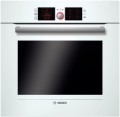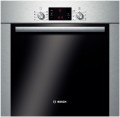Capacity
The working capacity of the oven. The amount of food that can be cooked in the device and the amount of space required for embedding depends on this parameter.
A capacity of about 50 – 60 litres is considered quite sufficient for a family of 2 – 3 people. It is the capacity that most modern built-in ovens have. However, there are other options — modest models of 20 – 30 litres, similar in capacity to microwave ovens,
large in capacity for home baking and large cabinets of 100 litres or more, designed more for cafes and restaurants than for home use.
Cooking temperature
The cooking temperature range allows you to understand which special tasks are subject to the oven. The lower temperature from which the oven starts heating, usually, is in the range of +30 to +50 ˚C. So, for example, the minimum heating temperature at
+30 ˚C allows you to defrost products. Models with a minimum of
40 ˚C and
50 ˚C allow you to heat ready meals, heat tableware (before serving), dry crackers, etc.
Cooking modes
Among the cooking modes, one can single out modes that are relevant for models in the role of ovens (these are
grill,
convection,
convection with heater,
double convection,
rotisserie fork,
temperature probe), as well as special operating modes that turn the oven into another device on the kitchen table (
microwave oven,
built-in steamer and
steam cooking)
— Microwave. The presence of a microwave heater in the oven, along with an electric or gas one (see "Oven"). This feature significantly expands the functionality of the device: a microwave generator is convenient for heating and defrosting food, and its use in combination with the main heater allows you to speed up the cooking time and provide better heating, especially when cooking the product as a whole piece (for example, when baking boiled pork). At the same time, such combined ovens are more expensive than
conventional ones not equipped with a microwave.
— Built-in steamer. Possibility of using the oven for steam cooking. Cooking is carried out in the main chamber of the oven, and the steam comes from a special reservoir into which water is poured in advance. This method is con
...sidered more healthy than traditional cooking or frying. In addition, it often turns out to be optimal for people with dietary restrictions. However, models with steamer functions are also more expensive than usual ones.
— Steam cooking. Water is poured into a special tray at the bottom of the oven, and evaporates under the influence of high temperature, thereby steaming the dishes in the device. However, such ovens have basic capabilities and do not have a separate programme, modes, or sensors that would monitor the work and the steam cooking process itself.
— Grill. Device for cooking food using thermal radiation. The grill allows you to get dishes with a fried surface or crispy crust. However, this method of cooking is considered healthier than frying in oil. This function is especially useful in combination with a rotisserie fork (see below).
— Convection. This function implies the presence of a fan in the oven, which forcibly draws heated air through the working chamber. It ensures a more even distribution of heat than with natural (without a fan) air circulation, which has a positive effect on the heating efficiency and the quality of cooking.
– Convection with heater. The combination of convection for uniform distribution of heated air flows and an annular heater, which is located around the fan. In this cooking mode, an increase in the temperature of the air driven by the blades is ensured. This type of dry convection is more efficient as it allows the circulating air to warm up evenly faster.
— Double convection. Improved convection function (see above), in which two fans are responsible for air circulation at once. According to the manufacturers, this ensures the evenest distribution of hot air throughout the volume of the oven and, accordingly, high-quality cooking. In addition, double convection is found in models with an additional chamber — where each fan is responsible for its own oven compartment.
— Rotisserie fork. A device in the form of a fork on which pieces of meat, chicken or other food can be strung. When cooking, this fork rotates, which allows you to evenly heat the dish from all sides. In modern ovens, this function is necessarily combined with a grill (see above); other cooking methods for a rotisserie fork are of little use or do not make sense.
— Temperature probe. A device for measuring the temperature of cooked food. It looks like a thin rod with a temperature sensor at the end. With such a rod, you can measure the temperature both outside and inside the dish being prepared, determining its condition and degree of readiness. Temperature probes are especially useful when roasting meat.
— Double oven. The ability to cook two different dishes at the same time in the oven saves time — for example, you can bake meat in the upper chamber and cook cake layers in the lower one. And the role of a partition between the chambers is played by a baking sheet, which can be removed and the oven used for a total volume.
— Custom programme. Ability to create your own oven programme. Such programmes are similar to automatic ones (for more details, see “Number of automatic programmes”). However, unlike the latter, you can change them at your own discretion and save them in the oven’s memory, which gives you ample features to customize the oven to your preferences.
— Defrosting. A programme for gentle defrosting of frozen foods. In this mode, the oven operates at a low intensity — so that the contents effectively thawed but, at the same time, did not bake. Data on the defrosting time required for a certain amount of a certain product is usually given in the instructions for use.Number of modes
The number of cooking modes provided in the design of the oven. In this case, the cooking mode means the general opertaion mode — for example, “heating”, “heating + convection”, etc. Accordingly, this indicator strongly depends on additional equipment (see "Features"). However, even in similar models, the number of modes may be different. In general, the
more cooking modes, the more cooking options, the easier it will be to choose the optimal mode for a specific situation.
Number of automatic programmes
The number of preinstalled cooking programmes stored in the oven's memory — usually designed for a specific dish or just
a defrost mode. If you have the appropriate programme, you do not have to keep track of the time, manually change the temperature and rearrange the dish in the oven — just put the ingredients there and start the programme, and the device will do the rest on its own. At the same time, unlike individual cooking modes (see above), the programmes are more complex — they provide changing temperatures, turning on special modes, turning off when time has elapsed, etc. The larger the set of automatic programmes, the wider the possibilities of the oven; their number in modern models can be in the tens. On the other hand, such programmes cannot be changed at will, so if you need both creativity and maximum convenience, you should pay attention to models with the ability to record
custom programme in memory.
Number of door glasses
The number of layers of glass in the viewing window of the oven door.
Modern models, usually, have from 2 to 4 glasses. The
more glasses, the less heat loss and the more economical the oven, but this parameter also affects the cost.
Door closer
The presence of an
automatic door closer in the design of the oven.
Such a device is responsible for pulling the door when closing, and in some models, when opening. The idea is that the user does not need to close/open the door completely — just pull it to the right place, and then the door will be smoothly brought to a fully open or closed state by the door closer. Such a system performs two functions. Firstly, it reduces to almost zero the risk of leaving the oven not completely closed (which is fraught with various unpleasant situations): the auto-closer is usually able to attract even a fairly wide open door. Secondly, such a device provides a very smooth opening and closing, without shock, which has a positive effect on the service life of the entire oven.
Guides
Type of guides for installing baking sheets that are used in the oven.
—
Frame. Classic guides have the form of slots with protrusions in the side walls of the oven. This design is simple and inexpensive. However, it is not very convenient — when removing baking sheets, you have to pull your hand into a heated oven, which means you will need a mitten or potholder. And the extraction itself may require effort, especially if the guides are dirty and the trays go tight in them.
—
Telescopic. Retractable guides on which the baking sheet “leaves” the oven, usually, immediately when the door is opened. Such devices are more convenient than frame ones, but they are more expensive and not suitable for all situations (for example, sometimes to check a dish you only need to open the lid without pulling it out). Therefore, in most models,
telescopic guides are only on one level. But
telescopic guides on two levels or even
three levels already classifies the device as a top segment.
Oven cleaning
The type of inner cleaning provided in the oven. Note that pollution has to be removed with a rag or sponge, but modern ovens often provide various tricks that facilitate the process. The options might be:
—
Catalytic. A special wall coating is used in ovens with this cleaning method: it breaks down fats and other stubborn dirt into constituent elements that can be easily removed. The effectiveness of such a coating decreases over time, but it is enough for at least several years of full use. It should be noted that the catalytic coating can be implemented by applying it to special removable plates that are installed on the back or side walls of the oven chamber.
—
Steam cleaning. Cleaning with hot steam, which softens dried-on dirt and partially breaks down fats. In some models, there is a built-in steam generator for this, in others it is enough to put a container of water in the working chamber and turn on the cleaning program.
—
Pyrolytic. Cleaning by heating the chamber to a very high temperature — about 500 ° C. At this temperature, most of the contaminants are incinerated into ash, which can then be easily removed. Pyrolytic cleaning is considered the most effective, but ovens with this function are expensive, time consuming, require significant electricity/gas consumption, and can lead to unpleasant odors.

